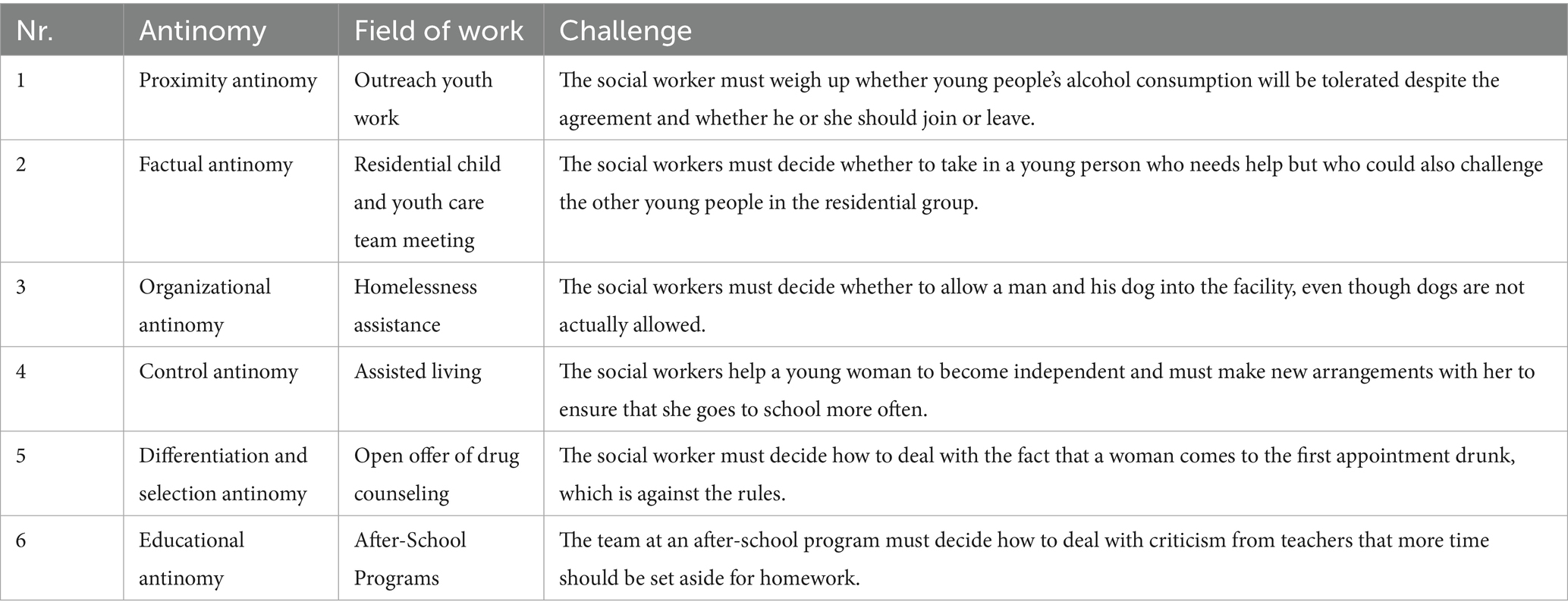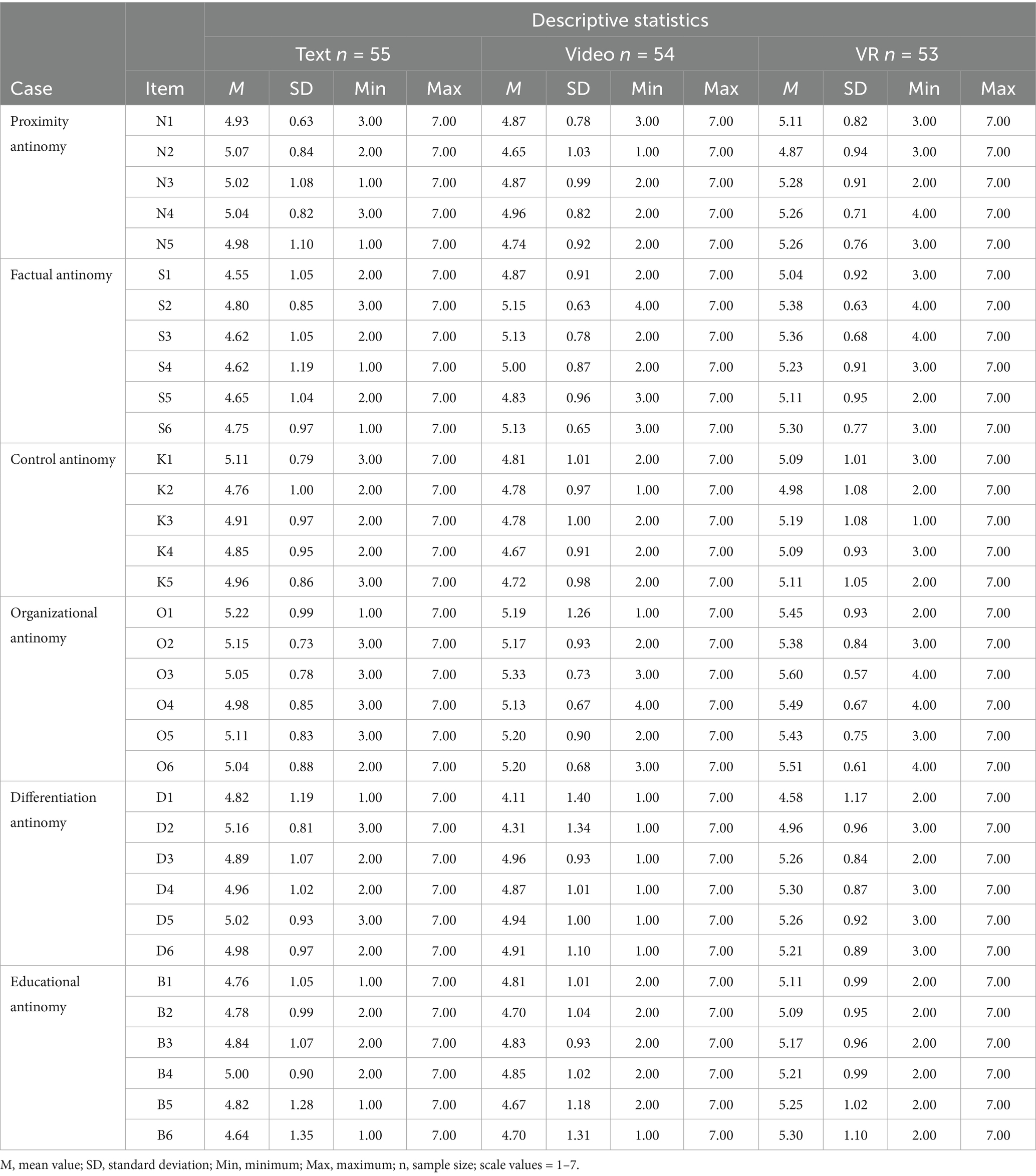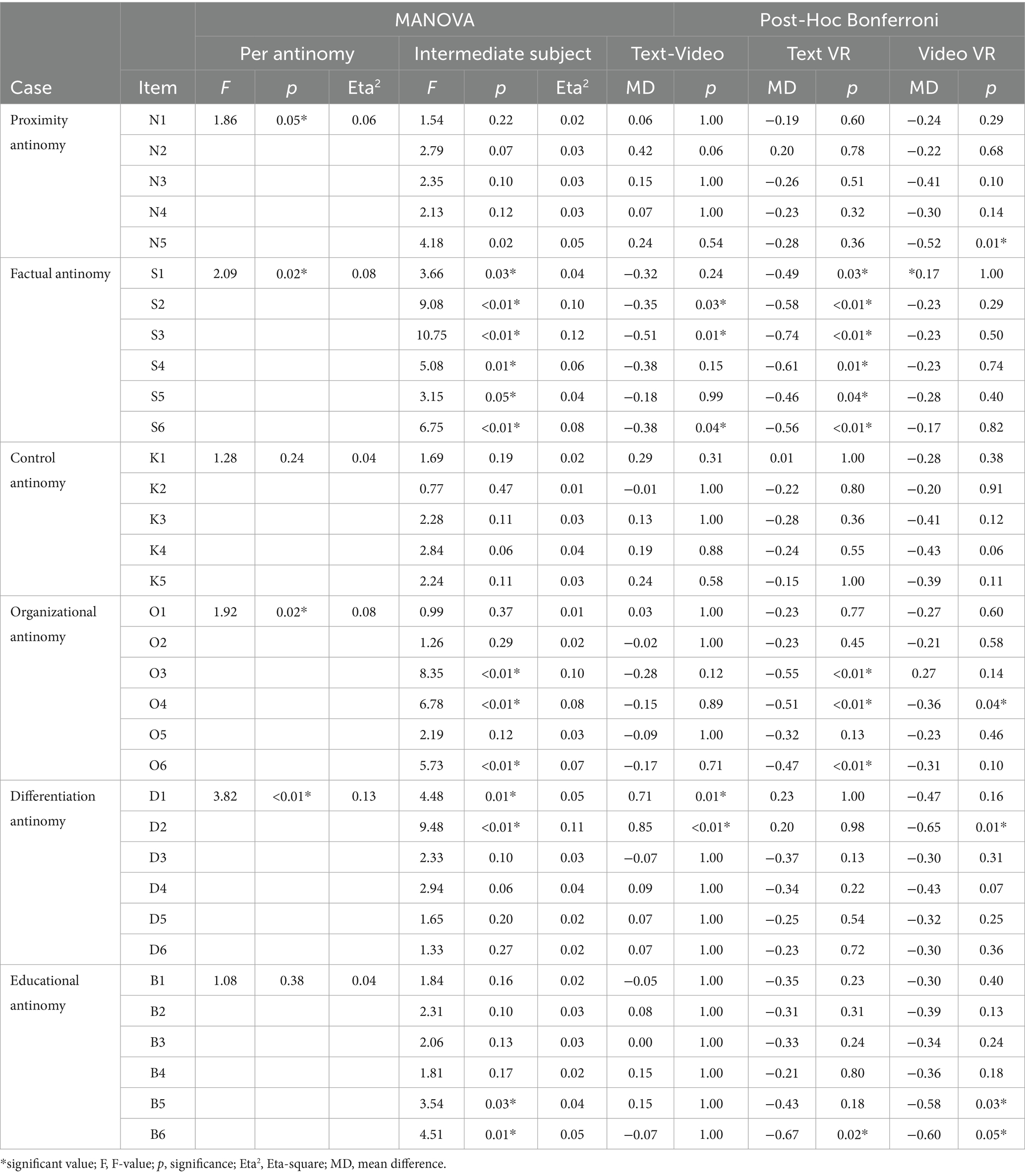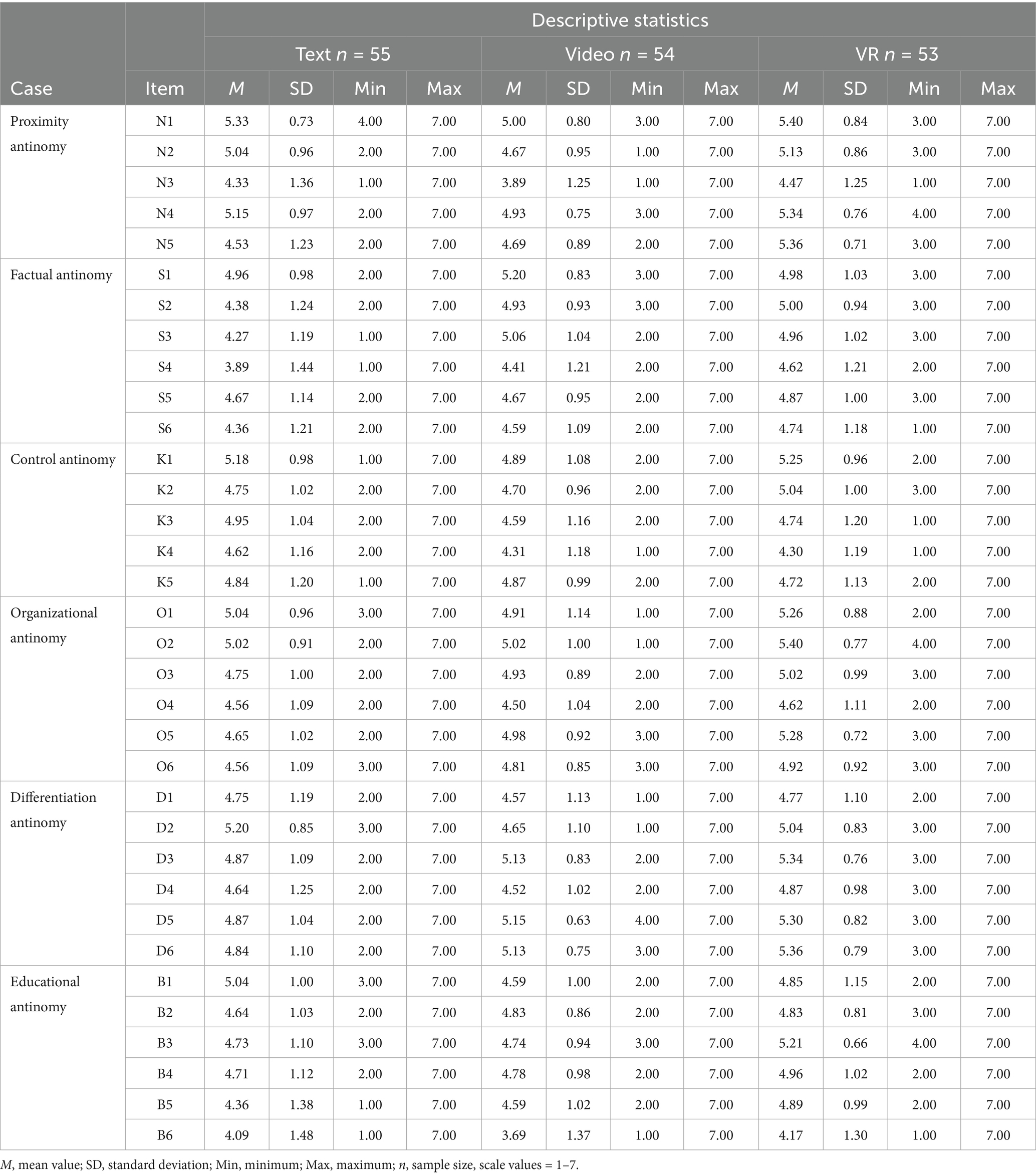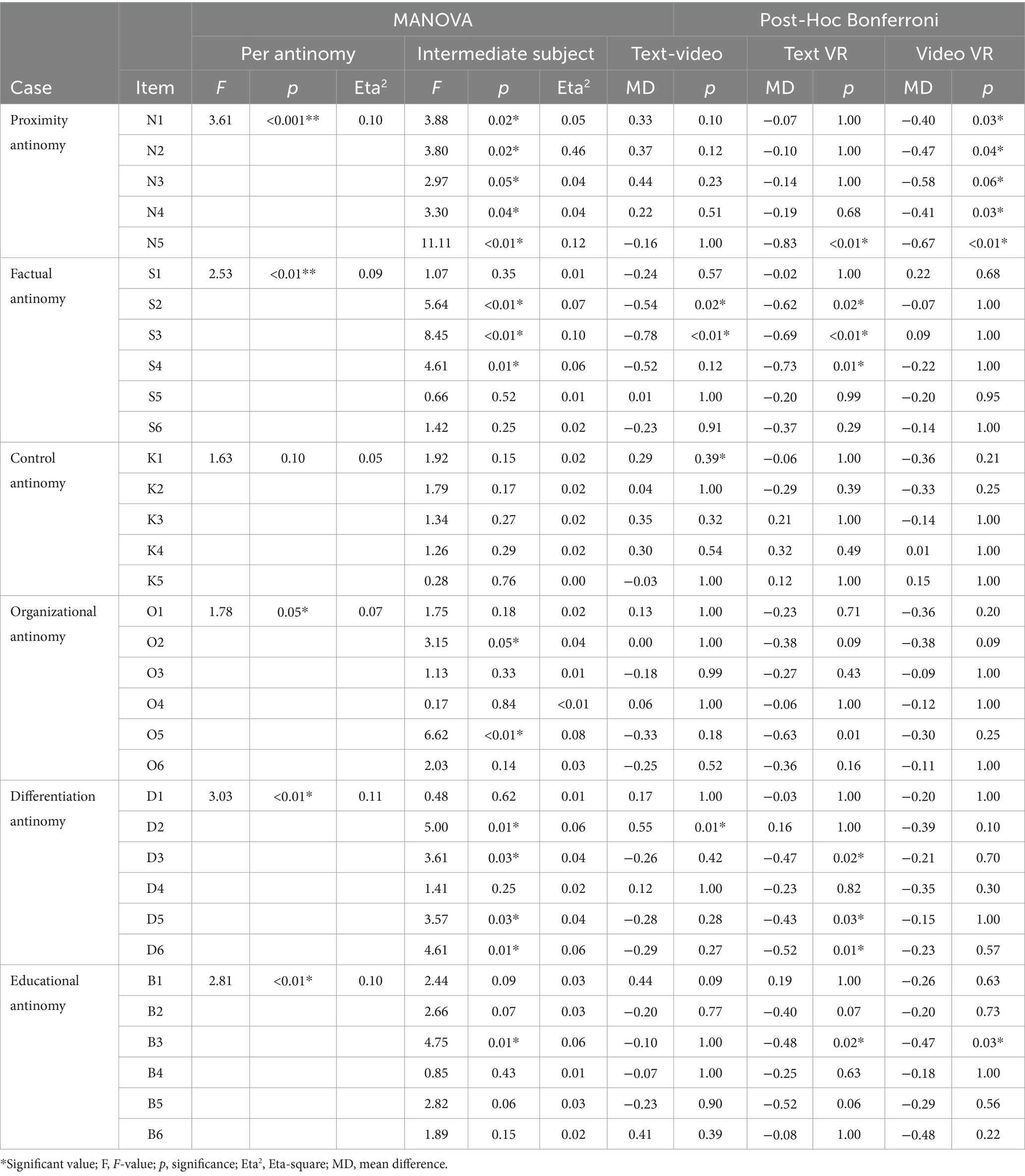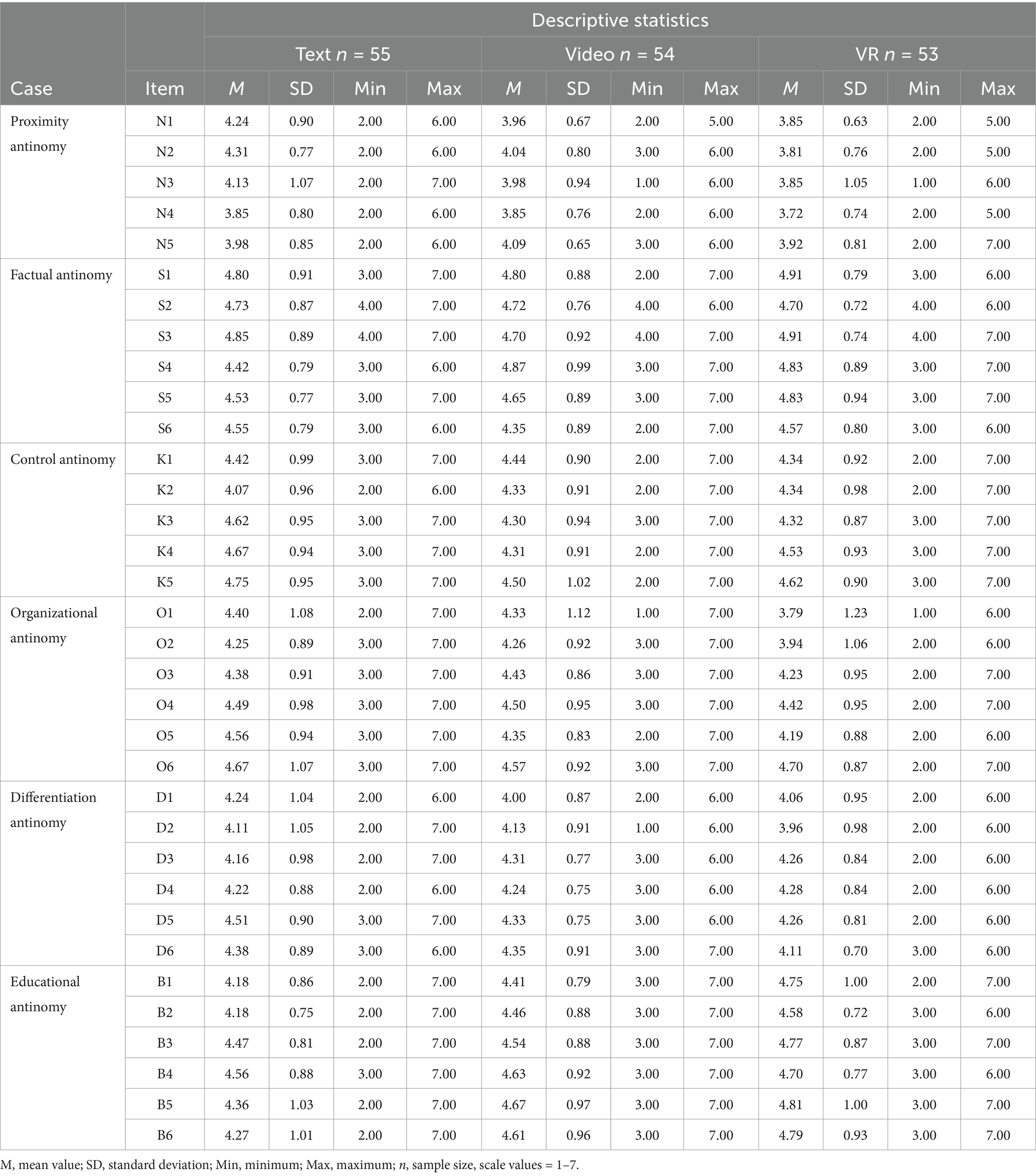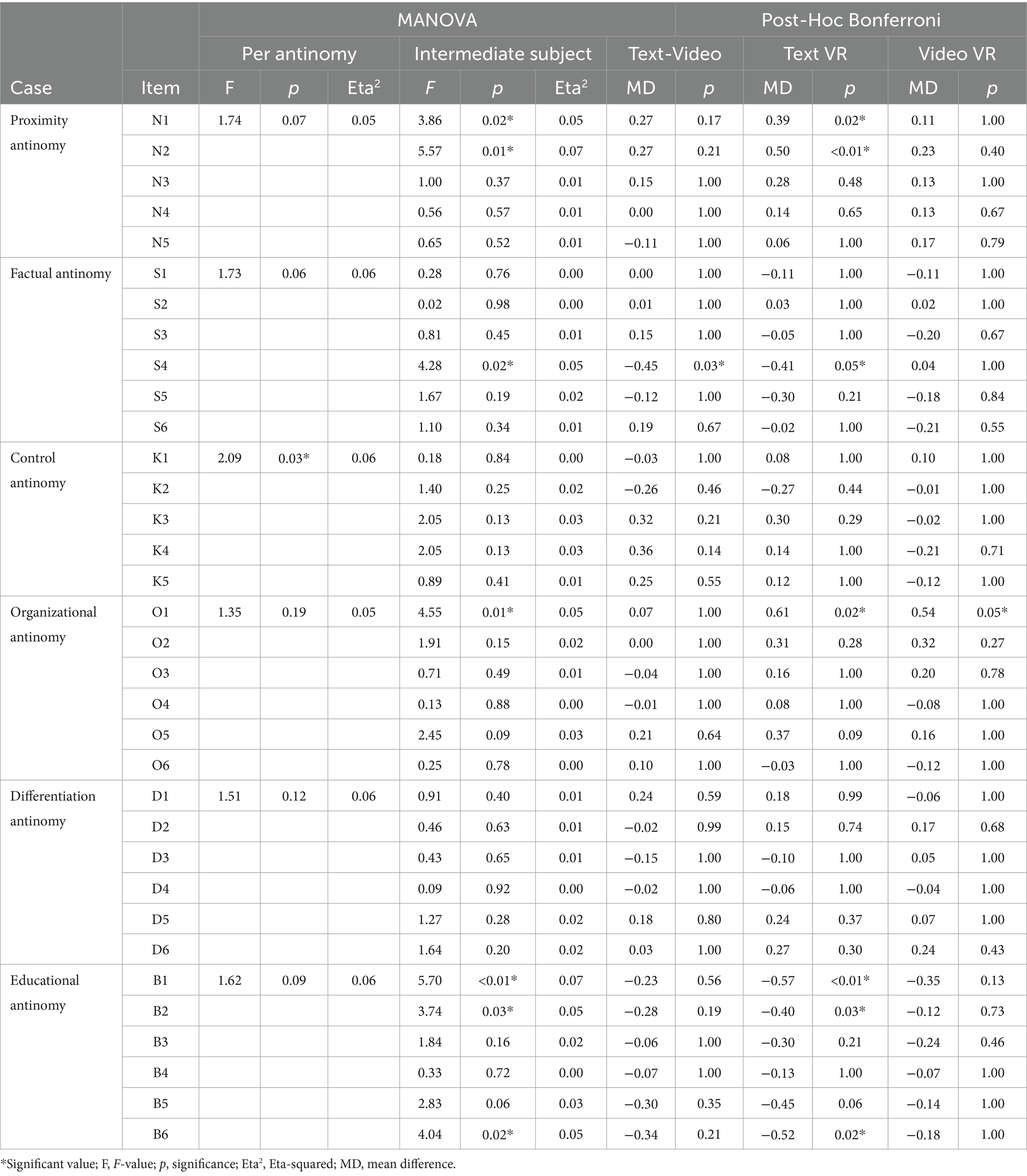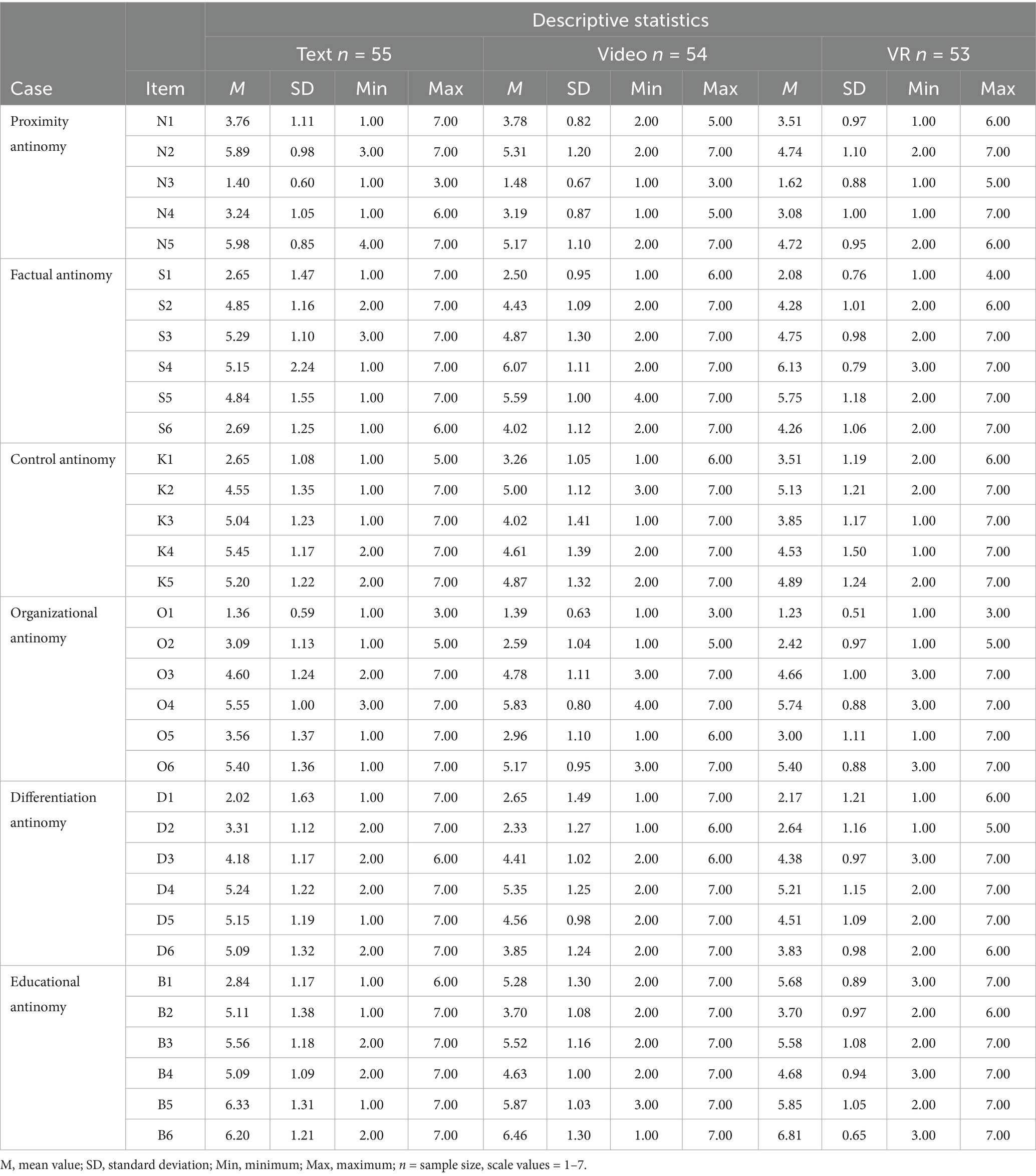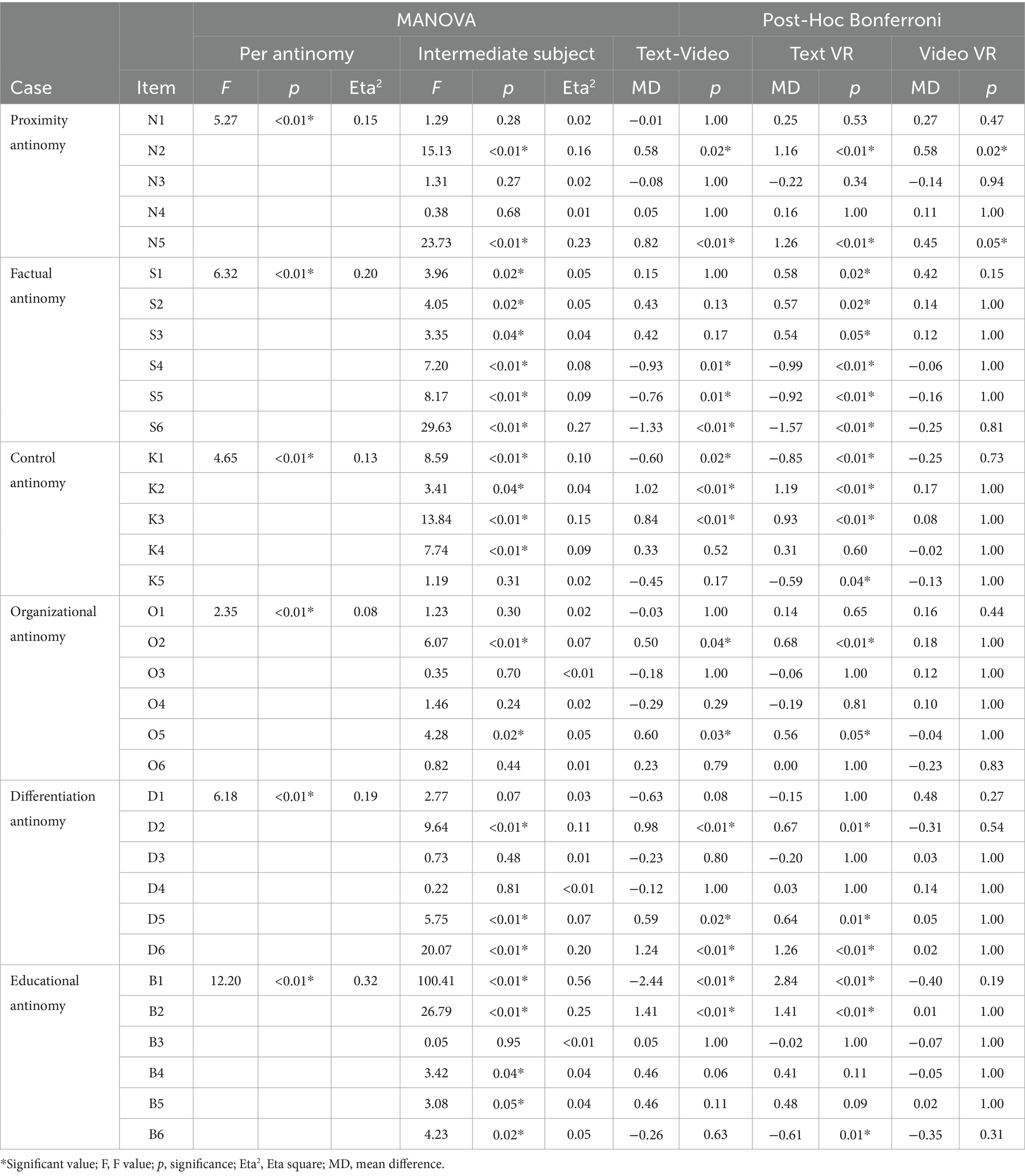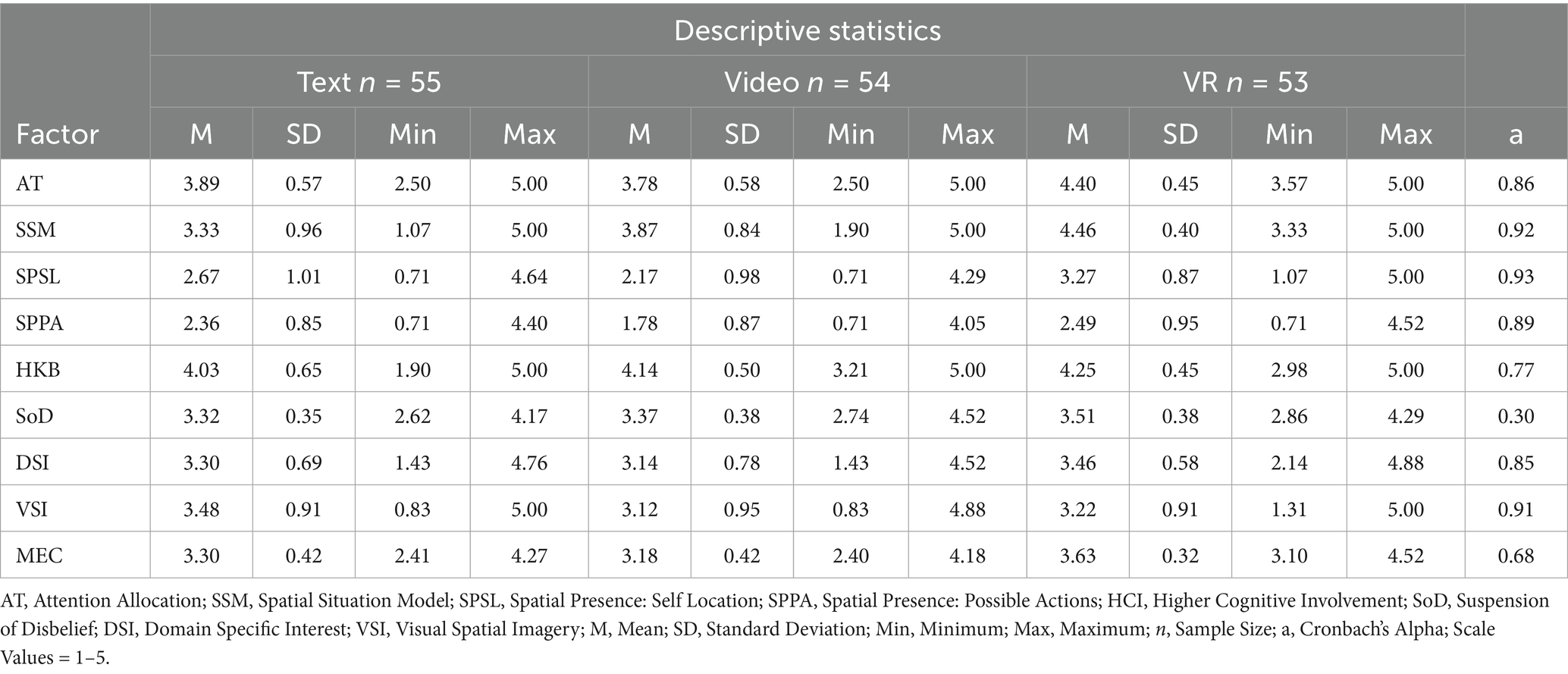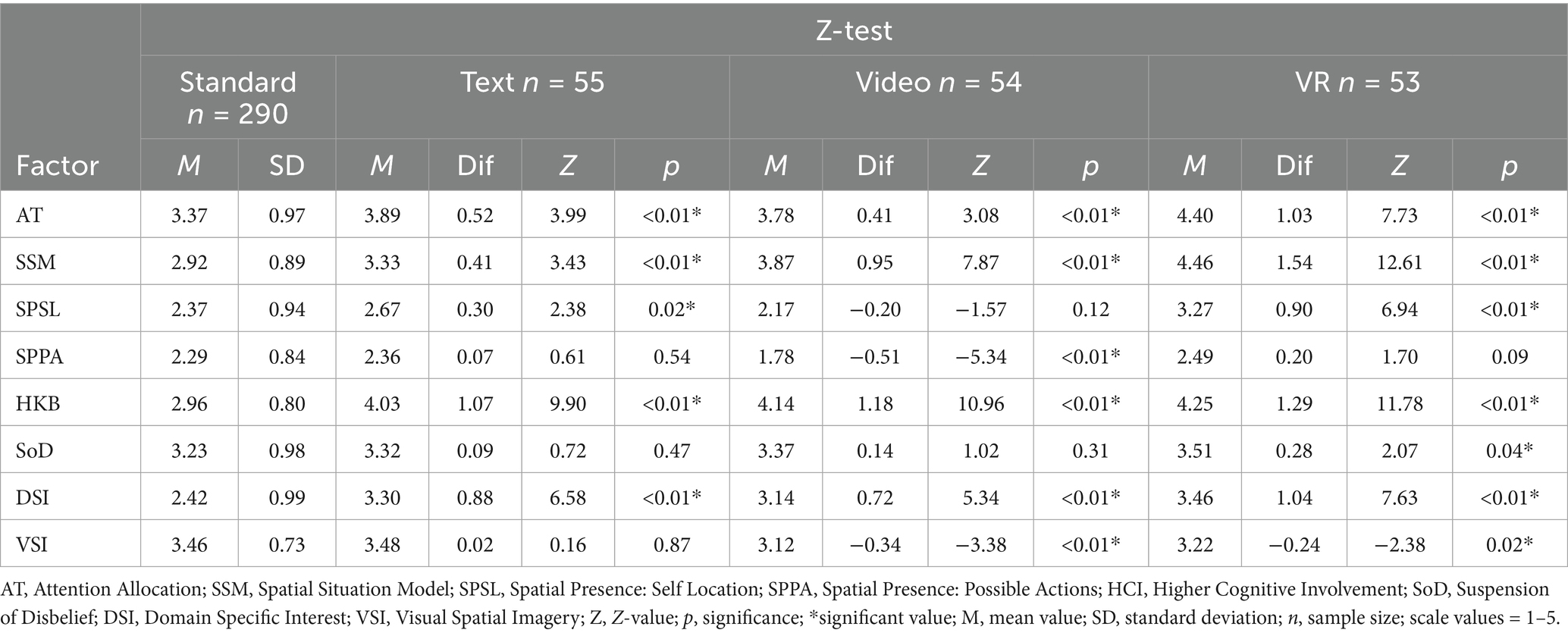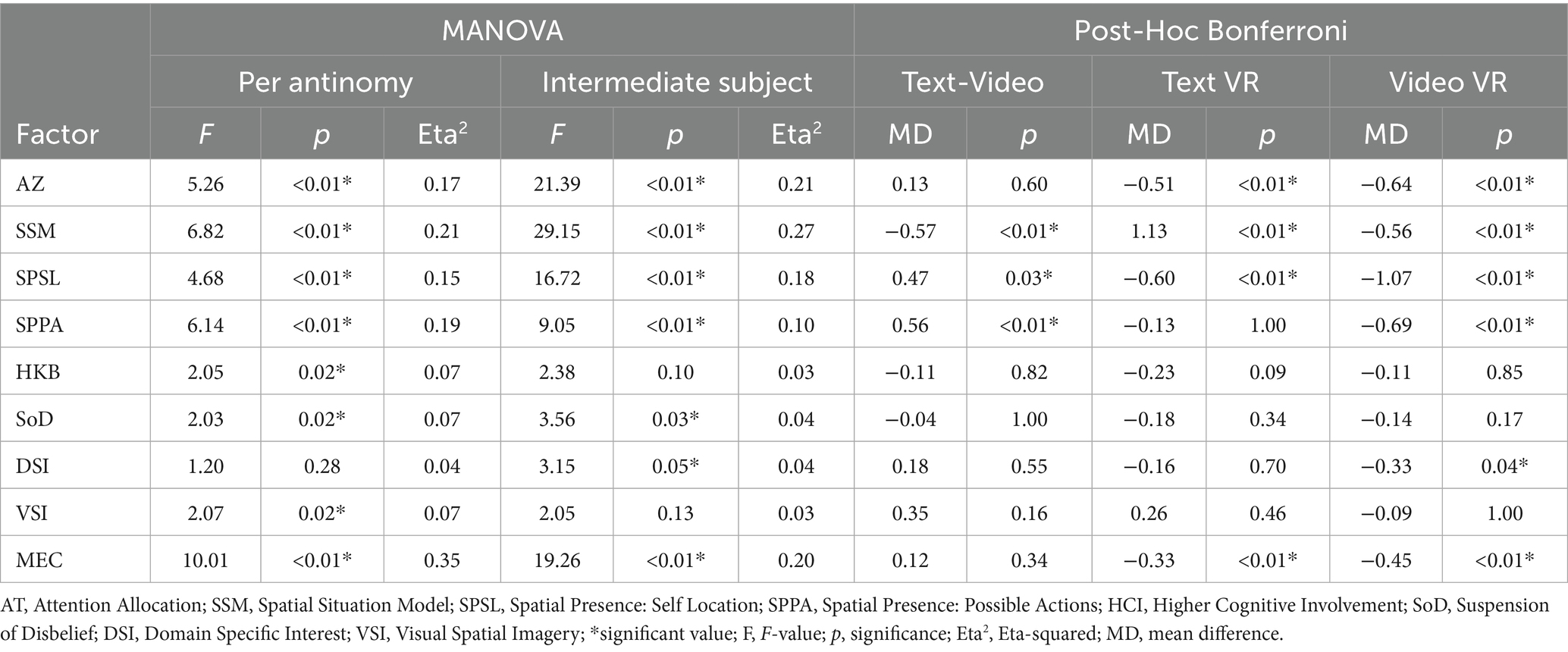- 1Institute of Social Work at the University of Applied Science (FH), Münster, Germany
- 2Institute of Health Sciences at the University of Lübeck, Lübeck, Germany
In social work, constitutive antinomies represent permanent tensions in practice that can only be addressed reflexively in teaching. In order to convey these, a direct transfer from theory to practice is necessary, which is presented, among other things, in the form of vignettes (hypothetical situations for teaching and research based on real cases). The present study examines three types of vignettes in order to ascertain the most beneficial teaching approach for social work: 1. Text vignettes are written descriptions of hypothetical situations. 2. Video vignettes offer a standardized perspective on the situation, presented in the format of a film. 3. Virtual reality (VR) vignettes allow viewers to select their own perspective within a 360° video, thereby providing a realistic representation of the situation. The results are compared based on the dispersion of the target and actual states of the vignettes, their practical relevance, explicitness, presence experience and flow experience. Within a randomized control group design (text n = 55, video n = 54, VR n = 53), three main hypotheses on the added value of VR vignettes were investigated in comparison to the comparison group of video vignettes and the control group of text vignettes. The results show that VR vignettes enhance the theory-practice transfer. This is partly because they have better content validity and a higher immersion experience than text and video vignettes.
1 Introduction
Technical developments are constantly providing new impetus for research into new aspects and approaches to the use of VR glasses. The establishment of the Meta Quest 2 VR headset was a milestone, as it offers a low-threshold access route for research and teaching with 360° videos. It enables 360° videos to be viewed three-dimensionally with the synchronization of head movement, which makes it possible to look around realistically in 360° videos. Initial studies on the use of 360° videos and VR glasses have revealed positive aspects and possible applications. Positive aspects were highlighted in a meta-study of 64 studies by Pirker and Dengel (2021), p. 83 which included the factors of improved knowledge transfer, understanding-promoting experience, increased motivation, increased performance and increased emotion transfer, as well as increased perception. Building on these overarching positive factors, the increase in empathy and compassion through VR glasses was confirmed in prospective professionals in the social and health sector (Wilding et al., 2022, p. 2). The positive aspect of the 360° videos’ all-round view, which enables practice from different perspectives and with different focal points of analysis, was mentioned most frequently (Rosendahl et al., 2023, p. 798).
In a comparison (n = 360) between 360° videos, augmented reality (AR) apps and classic instructional videos on attention during their use, it was demonstrated that attention was greatest with the 360° videos (Veber et al., 2023, p. 14). Furthermore, Barnidge et al. (2021), pp. 12–14, examined the degree of immersion and its impact on learning outcomes when comparing the use of 360° videos, 360° videos utilizing VR glasses, and text examples on the effects of climate change. The study found that the 360° videos using VR glasses were perceived as the most immersive, with no significant differences between the three types in terms of learning outcomes.
In a similar study design, which included 360° videos with VR glasses, 360° videos via laptop and classic 2D videos, the improvement of prospective teachers’ perception and attention skills was investigated (Ferdig and Kosko, 2020, pp. 852–853). Using an 18-point questionnaire, the immersion, presence and evaluation of the video results were evaluated using a six-point Likert scale, which required the respondents to clearly assign their subjective experience to a positive or negative side (1 = strongly disagree, 6 = strongly agree). Significant differences between the three groups were found in the area of immersion, with the 360° video via VR glasses receiving one of the highest ratings. Significant correlations were found between immersion and presence, immersion and video rating and presence and video rating (Ferdig and Kosko, 2020, pp. 852–853). The two studies cited in the control group design argue that research in the field of 360° videos for teaching must be intensified so that they can be used in a well-founded manner.
Contexts have been found between the flow and presence experience,1 with the presence experience influencing the flow experience (Kwon, 2019, pp. 105). On this basis, it can be hypothesized that video and VR case studies in teaching enhance the transfer of practical experience through the provision of an immersive experience, the focus it engenders, the increased motivation it generates, and the experience of flow it facilitates.
Regardless of the specific context, social work professionals must operate within a field shaped by various antinomies (Mennemann and Dummann, 2020, pp. 79–82). These include:
1. The proximity antinomy (proximity vs. distance)
2. The factual antinomy (factual orientation vs. lifeworld orientation)
3. The organizational antinomy (rules and routine vs. openness)
4. The control antinomy (control vs. help)
5. The differentiation and selection antinomy (homogenization vs. differentiation)
6. The educational antinomy (general education vs. pedagogical action)
These antinomies, which are taught already in the foundation course, represent omnipresent tensions in social work, requiring professional action to be reflexively oriented toward both sides. This is where the examination of vignettes comes in handy to promote skills of analysis and reflection and to sensitize students to practical situations through experience-based learning with the help of VR glasses and their experiential character (Kwon, 2019, p. 101). The use of 360° videos and VR glasses can prove to be a useful teaching tool for promoting external perception, a change of perspective and empathy (Christofi et al., 2022, p. 5). As innovative teaching- learning methods VR vignettes could help to strengthen practical relevance and support teaching-learning processes (Rosendahl and Wagner, 2023, p. 2), but they need to be critically analyzed and substantiated. This is where the article comes in and aims to compare the three types of vignettes with each other, highlight their respective advantages and disadvantages and formulate recommendations for the didactic use of the respective types of vignettes based on result.
In addition to the need for an authentic learning situation and the relationship between theory and practice, the question of methodological and didactic design options arises at the same time (Rosendahl and Wagner, 2023, p. 31). The current state of research is expandable in the context of a comparison of the three different types of vignettes but allows the formation of hypotheses for research in the control group design. Case work is a fundamental building block for the acquisition of analytical skills in the study of social work, so that research into it appears worthwhile for the teaching of social work. The development of possible areas of application and its foundation fulfills the demand of the Conference of Ministers of Culture (2021) to build up future-oriented competences in the field of VR in the context of media ethics and pedagogical issues (Kultusministerkonferenz, 2021, p. 25). A teaching approach using 360° videos was tested and, among other things, the application showed positive feedback regarding a better understanding of the teaching content and the realism of the situations (Averbeck et al., 2024, p. 119). A considerable research gap is still seen in education with 360° videos when it comes to comparison with traditional video formats (Veber et al., 2023, p. 3) and text formats, studies with generalizable and transferable results are needed here (Rosendahl and Wagner, 2023, p. 33). This study achieves this by collecting comprehensive data on immersion, the flow experience and the content validity and variance of the vignettes for the three vignette types.
Based on these considerations, the following central question arises: “What influence can be attributed to the choice of medium when working with case vignettes in a comparison of text, video and VR vignettes?” This comparison is necessary in order to determine to what extent video-, text-, and VR-based vignettes can best support the theory–practice transfer within the degree program. Moreover, it addresses the reduction of practice shock situations and the enhancement of regular teaching through the integration of virtual practical experiences (Ustun et al., 2023, p. 1065).
The following three overarching hypotheses are derived from the theory and are reflected in the current state of research, the identified research gap and the research objectives:
1 The experts consider the content validity of the VR vignettes to be more consistent than that of the text and video vignettes.
This hypothesis is based on the fact that attention is higher within the 360° videos and that students can grasp more of the content within the 360° videos by actively allocating their attention (Ranieri et al., 2022, p. 1208). The 360° perspective, the associated realistic perspective and the situational view in turn suggest a better practical relevance and greater Explicitness of the 360° videos (Rosendahl and Wagner, 2023, p. 31).
2 In the expert rating, the scattering is lower for the VR vignettes than for the text and video vignettes.
Due to the higher number of impact factors on the viewer, the VR vignettes can be said to have a greater influence and therefore convey the content better (Guo, 2020, p. 50). In view of this derivation, the experts can judge the vignettes more consistently due to a higher number of factors and thus generate less dispersion.
3 VR vignettes can create a more immersive experience than text and video vignettes.
In principle, the quality of immersion depends on the content and the preparation and on the degree of immersion of the playback media, whereby the different intensities of immersion and the flow experience should be recorded using very similar content, the antinomies. The degree of immersion appears to influence learning motivation and perception of reality, meaning that this must be considered conceptually, didactically and scientifically when using 360° videos (Rosendahl and Wagner, 2023, p. 31).
Building on existing findings, this study presents the results of the comparison of the three vignette forms and, at the same time, the validated 360° videos, videos and texts that can be used in teaching to convey the topic of the constitutive antinomies of social work in an evidence-based manner. This approach enables an innovative transfer between theory and practice that was designed for the antinomies. However, the results achieved can be transferred to other topics and fields of work. The results of the study also serve to establish teaching methods using 360° videos and VR glasses, providing a foundation for their use in social work education.
2 Study design
The vignettes are validated with the help of quantitative expert surveys with professors and students. This process is based on the procedure for the development and validation of vignettes according to Rutsch (2016), which focused on the construction of “a vignette test to record subject-specific didactic knowledge in reading lessons among teachers.” This process represents an “expert rating” that can be used, among other things, to test newly developed instruments. The added value of expert rating is the direct link to the knowledge of the experts, the external perspective on the instrument and the assessment of the instrument as to whether it can measure the desired construct.
In the context of this work, experts are defined by the following criteria: Experts are professors (n = 3) of the basic courses “Discipline and Profession” or “Social Work in an Interdisciplinary Context” at the Department of Social Work of Universities of Applied Sciences, who teach the constitutive antinomies within their own teaching activities. Experts are also students (n = 153) who have completed at least one of the two basic courses with a grade average within the top 30% of the grade spectrum, since the antinomies represent fundamental course content and the students can demonstrate a good knowledge of these. These student courses form the initial segment of the social work degree curriculum and are completed in the first half of the qualification. This full-time curriculum is typically pursued by students immediately following their formal education, and less frequently, after completing vocational training. Students in the selected grade range were contacted by the examination office via a circular email inviting them to participate voluntarily. They then contacted the study coordinator to be randomly assigned to one of the samples. These criteria guarantee a secure knowledge base in the subject area of the selected constitutive antinomies and a mixture of professorial and student expert perspectives.
The survey phase of the study was completed in 2023. The results of the study do not allow any conclusions to be drawn about individual persons, partly because no demographic data was collected. The demographic data of the experts could not be collected from the professors, as the anonymity of this group could not be guaranteed. This is due, on the one hand, to the sample size and, on the other hand, to the context of the university, which allows a direct link to the individuals. Furthermore, no demographic data on students was collected, as the hypotheses did not focus on usability or the age range and gender of the students. In addition, there is a gender imbalance in social work studies, as can be seen in 2011, among other years: 15% of students are male and 85% are female (n = 16.121) (Khunou and Pillay, 2012, p. 122). In order to capture the affinity for the technological vignettes in the survey, the domain specific interest (DSI) of the respondents was assessed, which measures their interest in the form of presentation of the case studies (text, video, VR), so that this factor could be captured despite the lack of demographic data. In the laboratory setting, the respondents were given individual instruction on how to set up and operate the VR headsets in order to minimize differences in operating skills when assessing the vignettes.
2.1 Development of vignettes
Comparability is a decisive factor in the creation of vignettes, so that all three types are based on the same text-based initial situation and are designed according to the medium. The video vignettes are created directly from the 360° videos of the VR vignettes, so that the perspective taken and situation guidance using VR glasses represent the starting point for viewing the video vignettes. Six selected constitutive antinomies of social work are depicted; for each antinomy, a fictitious basic situation is set up in a vignette, in each of which five to six varying situational characteristics are embedded.
In the creation of vignettes, which simulate real situations in the form of hypothetical scenarios, antinomies are presented as complex, realistic and plausible dilemmas (Wilks, 2004, p. 80). In the context of the quality criteria for good vignettes, these require pedagogical knowledge, always exhibit a sense of urgency and analyze hypothetical patterns of action in the form of vignettes (Franz et al., 2020, p. 168). In this context, the vignettes in the initial form of the text examples were created in cooperation with two professors of social work, so that the professional framework, the realism of the topic and the formulation of the content is as practical as possible and at the same time understandable for the students. To this end, different fields of work in social work were taken up for the individual antinomies in order to reflect the plurality of social work within the vignettes2 as well, which are listed in the Table 1.
The challenges listed here are based on the fields of work in social work in Germany and can be completely different in other countries.
2.2 Comparison groups
An a priori power analysis using G*Power 3.1.9.4 was conducted to determine the required sample size for the multivariate analyses (MANOVA: Global effects, Pillai V, O’Brien-Shieh algorithm). Given the study’s three hypotheses with different dependent variables, separate power analyses were performed.
For the first two hypotheses, examining case study evaluations with four dependent variables (actual and desired state of the antinomy, clarity, and practical relevance), the analysis assumed f2(V) = 0.0625, α = 0.05, power = 0.80, and three groups. The required sample size was 126, ensuring sufficient power with the actual 162 participants.
For the third hypothesis on presence experience, eight dependent variables were analyzed with the same parameters, yielding a required sample size of 162, matching the actual sample size. Finally, for the flow experience, measured by two dependent variables, the required 99 participants were well exceeded by the 162 participants, ensuring high power.
2.3 Data collection
The video and text vignettes are first viewed or read by respondents in an online questionnaire and then rated using the scales; the VR vignettes use the same questionnaire in a laboratory setting, as VR glasses and instructions are required for viewing.
The experts validated the vignettes using the two scales of the current state and desired state, which depict the tense relationship at the two pools (proximity - distance). And two further 7-point scales (1 = Does not apply at all, 7 = Applies completely) for filtering to capture the Explicitness of the situation and the authentic practical relevance. For this purpose, all test subjects completed the questionnaires on flow experience and presence experience “MEC Spatial Presence Questionnaire (MEC-SPQ)” according to Vorderer et al. (2004) and “Questionnaire for recording flow experience” according to Rheinberg et al. (2003) after the entire VR, video and text vignettes. The questionnaire on the experience of presence (MEC-SPQ) has generally satisfactory Cronbach’s alpha values (0.826–932) (Wirth et al., 2008, p. 82). Satisfactory Cronbach’s alpha values (0.80–0.92) were achieved with the questionnaire for recording the experience of flow according to Rheinberg et al. (2003). The questionnaire can be downloaded3 as an open education resource in the original German and in translation for the VR vignette form and is structured identically for the other two forms.
The scales are based on the original 5-point and 7-point scales of the two validated questionnaires. In the interests of a standardized evaluation and comparability of the two questionnaires used, the scales were harmonized and converted into a 7-point scale. The reshaping increased the range for the evaluation method of the mean value comparison and can therefore lead to more differentiated results.
The assignment of the vignettes is randomized in that the students respond to the invitation email and are then assigned to one of the vignette types depending on the time of their response (each type with n = > 50). The professors (n = 3) work on all three vignette types, as they are considered to have the expertise to view the three types objectively from a didactic perspective. The study specified a minimum of three professors per vignette type to evaluate the vignettes. This prevents the results from being distorted by individual biases or preferences and ensures that they are evaluable despite conflicting distributions. Having three perspectives allows the professors’ views to be incorporated into the process more objectively. However, the fact that the professors are familiar with all three groups, as well as the research interests of the study design, represents a potential source of influence. This could not be avoided in this study design due to the small number of suitable professors specializing in the relevant area within the department.
2.4 Data analysis
The incomplete data sets are removed so that only complete data is available, thus avoiding potential bias. In post-production, the case vignette for control antinomy 6 was deleted due to errors, and an error was detected in the VR vignettes for one proximity antinomy during the data collection phase, meaning that a total of 34 case vignettes are still analyzed in the evaluation.
The analysis is hypothesis-led, whereby the hypotheses are confirmed or refuted using correlations, mean value comparisons, scattering tests, MANOVA tables, Z-test, Cronbach’s alpha and descriptive comparisons. Because of different types of vignettes (text, video, VR) on multiple dependent variables (such as presence and flow experience), a MANOVA is more suitable than an ANOVA because it allows the simultaneous analysis of these dependent variables and thus takes into account the interactions between them.
The first hypothesis is answered using the internal validation procedure of the vignettes, whereby the answer is provided by comparing the respective mean values of the variables. This includes the dispersion of the respective mean values, which are specifically analyzed in the second hypothesis. The differences between the three vignette types are analyzed using a MANOVA table.
The second hypothesis is answered with the help of scattering tests, which allow statements to be made about the respective scattering of the vignettes and can therefore map the scattering of the VR vignettes across the board. The differences between the three vignette types are analyzed using a MANOVA table.
The third hypothesis is answered by means of three analyses, on the one hand a mean value comparison for the presence experience and flow experience of the respective vignettes, as well as for the three vignette forms. For this purpose, the dispersion is included, as this shows the extent to which there are deviations and for which vignette forms the highest overlap of subjective experience prevails. For this purpose, the correlations between the presence and flow experience are calculated for the respective forms.
For the presence experience questionnaire used, acceptable reliability (a = 0.77–0.92) was found for seven out of eight factors, with one factor (SoD) showing no reliability, which means that the reliability of the overall value of the presence experience is in the acceptable limit range (a = 0.68).
Acceptable reliability (a = 0.69–0.83) was found in three of the four factors of the flow experience questionnaire used, with the FIIII factor of the worry component showing no reliability, so that overall weak reliability was achieved for the flow experience (a = 0.56).
The internal validity of the vignettes could be demonstrated using the MANOVA tables for the desired state, as the mean values are in a similar range across the different types and therefore only individual significant differences between the types are recognizable. This shows that the three vignette types depict the same content and correspondingly the same target states are generated among the respondents.
3 Findings
H1: The experts consider the content validity of the VR vignettes to be more consistent than that of the text and video vignettes.
The hypothesis can be confirmed by the unambiguity and practical relevance. The experts confirm that the VR vignettes have a higher practical relevance and better Explicitness, meaning that the content validity of this type of vignette can be confirmed as more consistent.
In a total of 30 of the 34 vignettes, the Explicitness of the case studies was rated most positively for the VR vignettes, meaning that the hypothesis can already be confirmed in principle. In addition, the video vignettes were rated the most negatively in terms of Explicitness, so that they scored the worst in 19 vignettes and the text vignettes were in the middle with 15 of the worst rated vignettes. This result may be related to the information conveyed, with the VR vignettes providing the most information about the situation by allowing respondents to look around freely and selectively pick out the aspects relevant to them (See Table 2).
In the following vignettes, significant differences between the groups (text, video, VR) were identified using an MANOVA table. A percentage of the variance in the differences between the groups can be explained (Eta2), but the values do not exceed the threshold of 0.2/20%.
There are 14 vignettes with significant differences, with negative differences between the text and VR vignettes in 10 cases, negative differences between the video and VR vignettes in four cases and negative differences between the text and video vignettes in three cases and positive differences in two cases. These differences clearly show that the VR vignettes perform significantly better in terms of Explicitness than the other two vignette types in 14 cases (See Table 3).
The practical relevance of the case studies plays a decisive role in the theory-practice transfer. This ensures that the vignettes listed here have a practical relevance and can be used in teaching for transfer purposes.
The practical relevance of the VR vignettes was rated best in 27 out of 34 vignettes, meaning that the hypothesis can also be confirmed in terms of practical relevance. The text vignettes scored the lowest in terms of practical relevance with 18 vignettes, although the difference is small compared to the video vignettes, which scored the lowest with 16 vignettes (See Table 4). These results may indicate a higher immersion value of the VR vignettes (hypothesis 3), whereby the practical relevance can be perceived more strongly. Overall, it can be deduced from this that the practical relevance is most pronounced in the VR vignettes with the most degrees of freedom of observation.
Using the MANOVA table, differences between the three vignette types are significantly confirmed in 14 of 34 vignettes, which are negative in new cases between the text and VR vignettes and in 5 cases between the video and VR vignettes. There are two negative and one positive difference between the text and video vignettes, so that the results are like those for unambiguity and the VR vignettes perform significantly better than the other two vignette types in 14 cases (See Table 5).
H2: In the expert rating, the scattering is lower for the VR vignettes than for the text and video vignettes.
To capture the scattering of the vignette types, the respective standard deviations are used, which can explain the width of the scattering and thus the variance. Overall, this hypothesis can be confirmed based on the scattering of the current and desired state, whereby the scattering of the desired state is not clearly the lowest for the VR vignettes, but the video vignettes show an equally low scattering.
Of the 34 vignettes, the text vignettes show the greatest scattering in the desired state a total of 19 times. It can be concluded from this that the text vignettes offer the greatest scope for interpretation. The video vignettes show these 9 times and the VR vignettes show it 6 times. The analysis of the greatest scattering is extended and reinforced by analyzing the smallest scattering. In the desired state of the antinomies, the lowest scattering is shown in 6 cases for the text vignettes, in 15 cases for the video vignettes and in 13 cases for the VR vignettes. This clearly shows that the highest level of agreement occurs in the video and VR vignettes and that these are therefore interpreted most consistently.
The hypothesis can be partially confirmed, as the VR vignettes are the least likely to show the greatest scattering and the video vignettes perform better with the smallest scattering. The difference here is small, so that it can basically be stated that the text vignettes show the greatest scattering, while the VR and video vignettes show the smallest scattering of the desired state. The desired state is conveyed most clearly using the video vignettes and the VR vignettes (See Table 6).
Significant differences between the three vignette types were only found in seven out of 34 cases, with one negative difference between the text and video vignettes, one positive difference between the video and VR vignettes, and three positive and three negative differences between the text and VR vignettes (See Table 7).
In the assessment of the current state, the text vignettes show the greatest scattering 21 times in total, the video vignettes show the greatest scattering 10 times and the VR vignettes 3 times. This is also confirmed by the lowest scattering, as the current states show the lowest scattering in six cases for the text vignettes, in eight cases for the video vignettes and in 20 cases for the VR vignettes. This can be used to confirm the hypothesis that the VR vignettes have the lowest scattering compared to the video and text vignettes. This can show that the latter offer the most information for categorizing the vignettes in terms of the tension between the antinomies (See Table 8).
Using the MANOVA table, a total of 22 significant differences between the three vignette types can be identified. There are six negative and 13 positive differences between the text and VR vignettes, one positive difference between the video and VR vignettes and five negative and 10 positive differences between the text and video vignettes. These differences can be explained by the fact that the video and VR vignettes are based on the same film material and therefore evoke similar judgments of the situations, while the text vignettes offer more room for interpretation for the experts (See Table 9).
H3: VR vignettes can create a more immersive experience than text and video vignettes.
Overall, there is a highly significant correlation between the experience of presence and the experience of flow, with a Pearson correlation coefficient of 0.385 with a significance of <0.001. According to Cohen (1988), this is a moderate correlation due to the value above 0.3, whereby a large correlation would be above 0.5 and a small correlation above 0.1.
For the comparison with the existing norm values, the 7-point scale was converted to a 5-point scale; the values for the experience of presence are listed according to the 5-point scale. The text vignettes show an experience of presence of M = 3.29 with a standard deviation of 0.42 (n = 55), the mean value for the video vignettes is 3.17 and the standard deviation is 0.42 (n = 54). The VR vignettes have a mean value of 3.63 and a standard deviation of 0.32 (n = 53), so that a higher experience of presence and greater agreement among the respondents can be confirmed here in accordance with the hypothesis (See Table 10).
A comparison with validated data (n = 290) (Vorderer et al., 2004) can be made for the experience of presence. Five out of eight positive and significant Z-values can be recorded between the mean values of the individual factors of the experience of presence for the text vignettes, four positive and two negative significant Z-values for the video vignettes and six positive and one negative significant Z-value for the VR vignettes. Thus, the standard values were mostly exceeded for the three vignette types and were only not achieved for three factors of the video vignettes and one factor of the VR vignettes (See Table 11).
Based on this comparison with the existing norm ranges, the experience of presence is perceived more strongly in the VR vignettes than in the text and video vignettes. Significant differences can be found between the three vignette types for each antinomy for seven factors and the overall experience of presence, and significant differences can also be found for the intermediate subjects for six factors and the overall experience of presence. Two positive and one negative difference between the text and video form, one positive and one negative difference in the factors between the text and VR form, as well as a negative correlation between these in the overall presence experience can be recognized. There are five negative differences in the factors between the video and VR vignettes and one negative difference in the overall experience of presence. These significant differences make it clear that the VR vignettes generate a significantly higher experience of presence (See Table 12).
Flow experience is present in all vignette types. Mean values are M = 4.80 (SD = 0.81, n = 55) for text vignettes, M = 4.62 (SD = 0.82, n = 54) for video vignettes, and M = 5.30 (SD = 0.66, n = 53) for VR vignettes. The higher mean and lower SD in VR vignettes indicate a stronger and more consistent flow experience, supporting the hypothesis (see Table 13).
The MANOVA table revealed significant differences between two of the four factors and the overall flow experience. There are no significant differences between the text and video vignettes, but there is a negative difference between the text and video vignettes in the factors and in the overall flow experience. In addition, there are two negative differences in the factors and one negative difference in the overall flow experience between the video and VR vignettes. This confirms that the VR vignettes generate a significantly better flow experience than the other two vignette types (See Table 14).
In the text vignettes, the flow and presence experience correlate significantly (n = 55, p = 0.010) with a moderate correlation of r = 0.343, so that a connection between the two can be confirmed. There is a positive covariance of 0.164, which confirms the statement of the correlation coefficient.
The video vignettes show no significant correlation between the flow and presence experience (n = 54, p = 0.390) with a weak correlation coefficient of r = 0.119 and a covariance close to 0.00 of 0.057, so that no connection between flow and presence experience can be confirmed here. The flow and presence experience of the VR vignettes correlates almost highly significantly (n = 53, p = 0.002) with a moderate correlation coefficient of r = 0.410 and a covariance of 0.121, meaning that there is a clear correlation between the two variables. Overall, the hypothesis can be narrowly confirmed, as the correlation is higher for the VR vignettes. Overall, the dependency of presence and flow experience can be confirmed in the form of the correlations, meaning that both must be considered when using the vignettes.
3.1 Discussion
The results of this study show a clear influence of the medium used on the perception and evaluation of the case vignettes. While VR vignettes were rated best in terms of immersion and practical relevance, text and video vignettes each have specific advantages in terms of scope for interpretation and feasibility.
The increased immersion of VR vignettes compared to the other modalities is a key finding of this study. This is consistent with earlier studies showing that VR technologies enable an increased experience of presence and flow (Barnidge et al., 2021, p. 12–14; Kwon, 2019, p. 112). A significant contribution lies in the differentiated consideration of the immersive qualities of VR vignettes compared to text- and video-based vignettes. While earlier studies have described the general immersion advantage of VR (Christofi et al., 2022, p. 5), this study shows that this advantage is particularly important for the perception of practical relevance and vividness of the case vignettes.
A critical point concerns the second hypothesis: while a lower dispersion of ratings suggests a more consistent perception, the results show that there are significant differences between media in only 7 out of 34 cases. This raises the question of whether the use of VR in an educational context is justified given the high cost and effort involved. VR technology requires investment in hardware, software and training, whereas text and video vignettes can be created and implemented with significantly less resources. The question should always be asked whether the intended added value justifies the high financial and organizational effort, so that the use of VR vignettes in the classroom should always be contextualized. This discussion is in line with previous work indicating that the benefits of VR are context dependent and not necessarily superior in every learning situation (Veber et al., 2023, p. 12).
4 Conclusion and future research
The respective vignette types can be assigned to different areas of application, which are based on the respective characteristics of diffusion, explicitness, practical relevance and presence and flow experience. The implementation must always be weighed against the required effort and the focused learning objective of the teaching content, so that the added value of the individual types can be reflected.
After analysis, text vignettes are a good starting point for assignments in which students are expected to develop individual perspectives and approaches and a wide variety of results is desired. Students interpret the initial examples differently and can generate a wide range of solutions, but this results in a rather low theory-practice transfer due to the experience-dependent practical relevance and imagination required for immersion. These examples are therefore recommended for theoretical discussion of course content and for intermediate tasks with case vignettes that do not require extensive technical preparation.
The video vignettes can provide a good starting point for uniform assessments of situations that are intended to generate the same solutions among students. The visualization allows for a slightly better practical relevance with easy implementation in a seminar context. However, due to the limited information provided and the excerpt-like presentation, this generates the lowest level of presence and flow experience in comparison, meaning that no deep immersion is achieved. Video vignettes can therefore be used didactically for the easy teaching of practical situations. Joint discussion and processing are advantageous here, as these vignettes exhibit the lowest level of clarity.
VR vignettes offer uniform and consistent starting points for case work. They generate the highest presence and flow experience, so that an immersive theory-practice transfer can be created. This allows students to gain as realistic and authentic an insight into practice as possible and to avoid potential practical shock situations. VR vignettes are therefore recommended for deepening practical insights and for analyzing one’s own perspectives and emotions when working methodically with vignettes. In this respect, VR vignettes can be chosen as an immersive supplement to existing content and methods, in order to convey certain aspects of the teaching content in a vivid way and to enrich the teaching with these experiences and analyses.
For further research, it makes sense to combine three building blocks of the current development of VR vignettes. A didactic approach has already been developed and tested here to use VR vignettes in the form of 360° videos in teaching (Averbeck et al., 2024, p. 116). By combining this approach with the findings presented here on the added value and differences between the various vignette formats, it will be easier for teachers to decide which vignette format is better suited to their teaching at which point in time. Further research will consider the didactic anchoring of the approach at a university, so that the challenge of the effort required to use VR vignettes at the university can be reduced and conveyed with the help of an example.
As a next step, future research should take a closer look at the long-term effects of VR vignettes on learning, as well as at the use of VR vignettes in exam formats, so that the didactic use of VR vignettes can be improved and expanded. Likewise, it is essential to consider factors such as motion sickness and cognitive stress, which may have negative effects on students. Further studies should examine these aspects more closely to deepen our understanding and improve innovative teaching and learning methods in higher education.
Data availability statement
The datasets presented in this study can be found in online repositories. The names of the repository/repositories and accession number(s) can be found at: https://openedu-rlp.de/edu-sharing/components/collections?mainnav=true&id=d68702a3-bf43-48dc-b6eb-5a92b7500420.
Ethics statement
The studies involving humans were approved by Ethics Commission of the University of Münster. The studies were conducted in accordance with the local legislation and institutional requirements. The participants provided their written informed consent to participate in this study.
Author contributions
FA: Conceptualization, Data curation, Formal analysis, Funding acquisition, Investigation, Methodology, Project administration, Resources, Software, Supervision, Validation, Visualization, Writing – original draft, Writing – review & editing. TU: Supervision, Writing – review & editing.
Funding
The author(s) declare that financial support was received for the research and/or publication of this article. Supported by the Open Access Publication Fund of FH Münster University of Applied Sciences.
Acknowledgments
The authors would like to thank the students of the Department of Social Work at Münster University of Applied Sciences for their cooperation. We would also like to thank the XR sub-project, which cooperated in the filming of the videos.
Conflict of interest
The authors declare that the research was conducted in the absence of any commercial or financial relationships that could be construed as a potential conflict of interest.
Generative AI statement
The authors declare that no Gen AI was used in the creation of this manuscript.
Publisher’s note
All claims expressed in this article are solely those of the authors and do not necessarily represent those of their affiliated organizations, or those of the publisher, the editors and the reviewers. Any product that may be evaluated in this article, or claim that may be made by its manufacturer, is not guaranteed or endorsed by the publisher.
Footnotes
1. ^The flow experience describes the cognitive immersion in an activity, which generates a stronger interest in learning (Barnidge et al., 2021), while the presence experience is made up of the place illusion, plausibility illusion, copresence illusion and social presence illusion (Della Libera et al., 2023, p. 2).
2. ^The vignettes created for the study and the questionnaire can be downloaded as an open education resource in German on the following page and used for teaching and research purposes: https://openedu-rlp.de/edu-sharing/components/collections?id=576933d1-2144-46b3-b9b0-6bbe7203895c.
3. ^https://openedu-rlp.de/edu-sharing/components/collections?mainnav=true&id=d68702a3-bf43-48dc-b6eb-5a92b7500420
References
Averbeck, F., Leifeling, S., Müller, K., and Schoenfelder, T. (2024). Virtual reality in social work teaching - two approaches to 360° videos and collaborative working. Electron. J. E Learn. 22, 111–123. doi: 10.34190/ejel.21.6.3225
Barnidge, M., Sherrill, L. A., Kim, B., Cooks, E., Deavours, D., Viehouser, M., et al. (2021). The effects of virtual reality news on learning about climate change. Mass Commun. Soc. 25, 1–24. doi: 10.1080/15205436.2021.1925300
Christofi, M., Hadjipanayi, C., and Michael-Grigoriou, D. (2022). The use of storytelling in virtual reality for studying empathy: a review. Available online at: http://getlab.org/wp-content/uploads/2022/08/2022_IMET_VRStorytellingEmpathyReview_Camera-ready_copyright.pdf (Accessed February 27, 2025).
Cohen, J. (1988). Statistical power analysis for the behavioural sciences. 2nd Edn. Hillsdale: L. Erlbaum Associates.
Della Libera, C., Simon, J., Laroi, F., Quertemont, E., and Wagener, A. (2023). Using 360-degree immersive videos to assess multiple transdiagnostic symptoms: a study focusing on fear of negative evaluation, paranoid thoughts, negative automatic thoughts, and craving. Virtual Reality 27, 3565–3580. doi: 10.1007/s10055-023-00779-y
Ferdig, R. E., and Kosko, K. W. (2020). Implementing 360 video to increase immersion, perceptual capacity, and teacher noticing. TechTrends 64, 849–859. doi: 10.1007/s11528-020-00522-3
Franz, E.-K., Wacker, A., and Heyl, V. (2020). expanding classroom management skills – working with case vignettes in the context of adaptive teaching. in Vignette-based learning in teacher training. Subject-related didactic and pedagogical perspectives. Friesen, M. E., Benz, J., Billion-Kramer, T., Heuer, C., Lohse-Bossenz, H., and Resch, M. (Weinheim, Basel: Beltz Juventa), 165–180.
Guo, Q. (2020). “User experience design and evaluation in immersive virtual reality environments” in Virtual, augmented and cross reality in practice and research. Technology-based worlds of experience in vocational education and training. Theory and application. ed. B. Zinn (Stuttgart: Franz Steiner), 31–56.
Khunou, G., and Pillay, R. (2012). Social work is “women’s work”: an analysis of student’s perceptions of gender as a career choice determinant. Soc. Work Pract. Res. 24, 120–135. Available online at: https://www.researchgate.net/publication/235639439_Social_Work_is_women%27s_work_an_analysis_of_student%27s_perceptions_of_gender_as_a_career_choice_determinant (Accessed July 19, 2025)
Kultusministerkonferenz. (2021). Teaching and learning in the digital world: the supplementary recommendation to the strategy 'education in the digital world'. Available online at: https://www.kmk.org/fileadmin/veroeffentlichungen_beschluesse/2021/2021_12_09-Lehren-und-Lernen-Digi.pdf (Accessed February 27, 2025).
Kwon, C. (2019). Verification of the possibility and effectiveness of experiential learning using HMD-based immersive VR technologies. Virtual Reality 23, 101–118. doi: 10.1007/s10055-018-0364-1
Mennemann, H., and Dummann, J. (2020). Introduction to social work. Social work course. Baden-Baden: Nomos.
Pirker, J., and Dengel, A. (2021). The potential of 360-degree virtual reality videos and real VR for education – a literature review. IEEE Comput. Graph. Appl. 22, 76–89. doi: 10.1109/MCG.2021.3067999
Ranieri, M., Luzzi, D., Cuomo, S., and Bruni, I. (2022). If and how do 360° videos fit into education settings? Results from a scoping review of empirical research. J. Comput. Assist. Learn. 38, 1199–1219. doi: 10.1111/jcal.12683
Rheinberg, F., Vollmeyer, R., and Engeser, S. (2003). “Recording the flow experience” in Diagnostics of motivation and self-concept (tests and trends N.F. 2). eds. J. Stiensmeier-Pelster and F. Reinberg (Göttingen: Hogrefe), 261–279.
Rosendahl, P., Müller, M., and Wagner, I. (2023). 360° videos as a visual training tool - a study on subjective perceptions. J. Phys. Educ. Sport 23, 795–801. doi: 10.7752/jpes.2023.04100
Rosendahl, P., and Wagner, I. (2023). 360° videos in education - a systematic literature review on application areas and future potentials 2023. Educ. Inf. Technol. 29, 1319–1355. doi: 10.1007/s10639-022-11549-9
Rutsch, J. (2016). Development and validation of a vignette test to assess subject-specific didactic knowledge in reading instruction among prospective teachers. Dissertation, Heidelberg University of education. Available online at: https://opus.ph-heidelberg.de/frontdoor/deliver/index/docId/215/file/Dissertation_Rutsch_Veroeffentlichung.pdf (Accessed Febraury 28, 2025).
Ustun, A. B., Karaoglan-Yilmaz, F. G., and Yilmaz, R. (2023). Educational UTAUT-based virtual reality acceptance scale: a validity and reliability study. Virtual Reality 27, 1063–1076. doi: 10.1007/s10055-022-00717-4
Veber, M., Pesek, I., and Abersek, B. (2023). Assesment of supporting visual learning Technologies in the Immersive VET cyber-physical learning model. Educ. Sci. 13:608. doi: 10.3390/educsci13060608
Vorderer, P., Wirth, W., Gouveia, F. R., Biocca, F., Saari, T., Jäncke, F., et al. (2004). MEC spatial presence questionnaire (MECSPQ): short documentation and instructions for application. Report to the European Community, Project Presence: MEC (IST-2001-37661).
Wilding, C., Young, K., Cummins, C., Bowler, C., Dean, T., Lakhani, A., et al. (2022). Virtual reality to foster empathy in disability workers: a feasibility study during COVID-19. J. Appl. Res. Intellect. Disabil. 36, –11. doi: 10.1111/jar.13042
Wilks, T. (2004). The use of vignettes in qualitative research into social work values. Qual. Soc. Work 3, 78–87. doi: 10.1177/1473325004041133
Wirth, W., Schramm, H., Böcking, S., Gysbers, A., Hartmann, T., Klimmt, C., et al. (2008). Development and validation of a questionnaire on the development of spatial presence experience. In The bridge between theory and empiricism: Operationalization, measurement and validation in communication science. Matthes, J., Wirth, W., and Daschmann, A. F. G. (Cologne: Herbert von Halem), 70–95.
Keywords: education, virtual reality, social work, vignettes, theory-practice transfer
Citation: Averbeck F and Utesch T (2025) Development of three vignette types of selected constitutive antinomies of social work: a study of the development and comparison of text, video and VR vignettes. Front. Educ. 10:1585137. doi: 10.3389/feduc.2025.1585137
Edited by:
Evi Agostini, University of Vienna, AustriaReviewed by:
Stephanie Mian, Free University of Bozen-Bolzano, ItalyGabriele Rathgeb, University College of Teacher Education Tirol, Austria
Copyright © 2025 Averbeck and Utesch. This is an open-access article distributed under the terms of the Creative Commons Attribution License (CC BY). The use, distribution or reproduction in other forums is permitted, provided the original author(s) and the copyright owner(s) are credited and that the original publication in this journal is cited, in accordance with accepted academic practice. No use, distribution or reproduction is permitted which does not comply with these terms.
*Correspondence: Felix Averbeck, RmVsaXguQXZlcmJlY2tAZmgtbXVlbnN0ZXIuZGU=
 Felix Averbeck
Felix Averbeck Till Utesch
Till Utesch